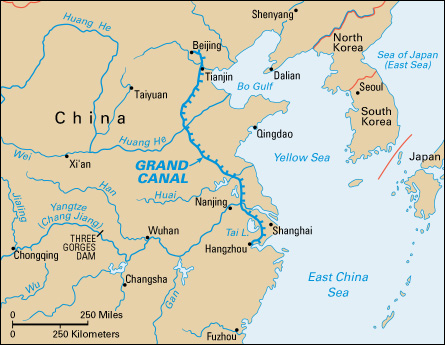Grand Canal, in China, is the world’s longest artificial waterway. It is a series of linked canals that stretches about 1,000 miles (1,600 kilometers). The Grand Canal runs from the city of Hangzhou in the south to Beijing in the north. It connects several of China’s major cities, including Beijing, Hangzhou, and Tianjin. It also links several major rivers, including the Huang He (Yellow River) and the Yangtze. The oldest portions of the Grand Canal date back to around 500 B.C.

Use of the canal.
The Grand Canal has been important to China’s economy for hundreds of years. Before the development of rail travel, the canal served as one of China’s main shipping and postal routes. Boats carried soybeans and other products from the north to southern areas of the Chinese Empire. Rice and other grains grown in the Yangtze River delta were shipped north to feed capital cities and standing armies. Although some sections of the Grand Canal are no longer in use, other sections remain important for the transportation of goods.
Some areas of the Grand Canal have long faced problems with the buildup of silt (fine-grained sediment). Silt buildups can make it difficult for boats to navigate rivers and canals. Efforts to dredge (clear out) the areas most affected by silt have had mixed results.
Parts of the Grand Canal also have been prone to flooding by rivers connected by the canal system. Throughout the canal’s history, engineers have constructed dams and locks to control the flow of these rivers and limit the damage caused by flooding.
History.
Construction of the oldest portions of the Grand Canal began around 500 B.C. during the Zhou dynasty (1045-281 B.C.) The canal was expanded during the Sui dynasty (A.D. 581-618), when a number of rivers and existing canals were connected. The emperor wanted to make it easier to transport grain from the fertile basin of the Yangtze to the empire’s political and military center in the north. By 610, the canal system connected the southern port city of Hangzhou; the Yangtze, Huang He, and other major river systems; and the area around what is now Beijing.
During the Mongol, or Yuan, dynasty (1279-1368), the emperor Kublai Khan ordered the construction of new waterways. With the completion of the new sections in 1327, the Grand Canal reached its current form, linking Hangzhou and Beijing with a continuous and direct north-south waterway. However, as the power of the Yuan dynasty waned, the canal system fell into disrepair.
The Grand Canal was repaired in the early 1400’s during the Ming dynasty (1368-1644). In addition to functioning as a major trade artery, the waterway also served as a courier route during this period. The canal continued to function as a key trade and courier route into the Qing dynasty (1644-1912). In the mid-1800’s, the flooding of the Huang He and the spread of railroads caused canal traffic to decline drastically. The imperial government was focused on developing and managing foreign trade along the coast, and much of the Grand Canal again fell into disrepair.
In the 1950’s, the Chinese government established a committee to oversee the restoration of the waterway. Engineers constructed a series of dams to control flooding and to help with drainage and irrigation. Today, the canal continues to be important for transporting bulk goods in China.
